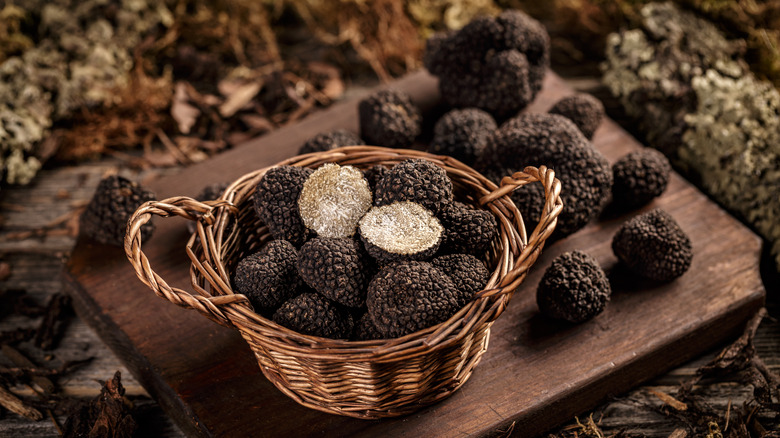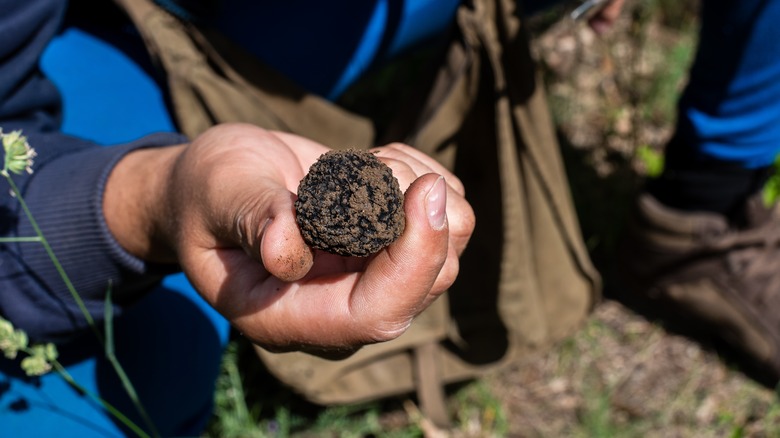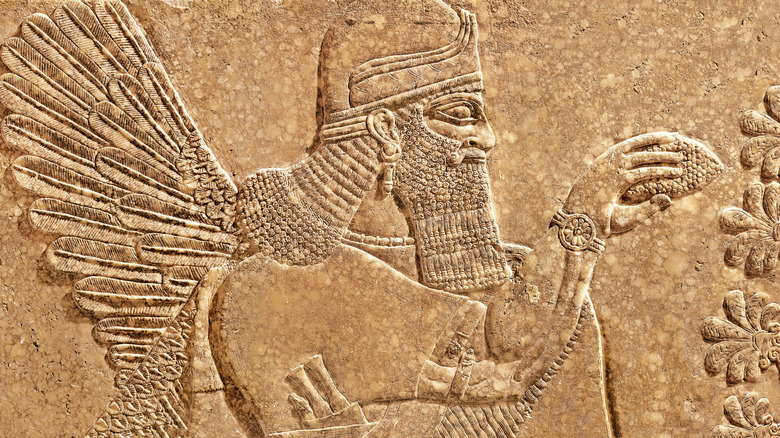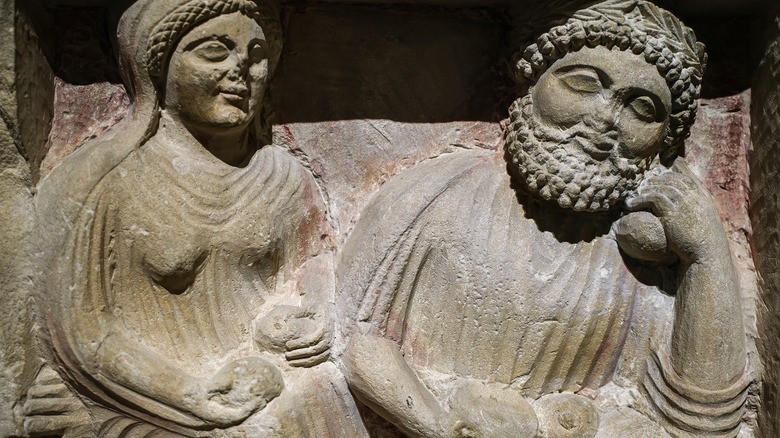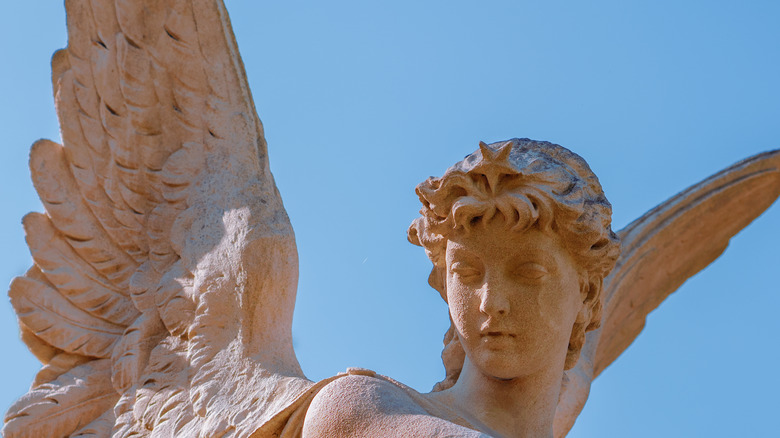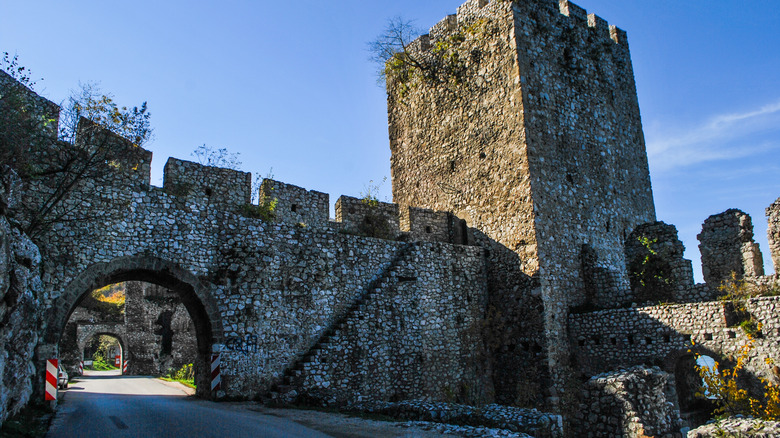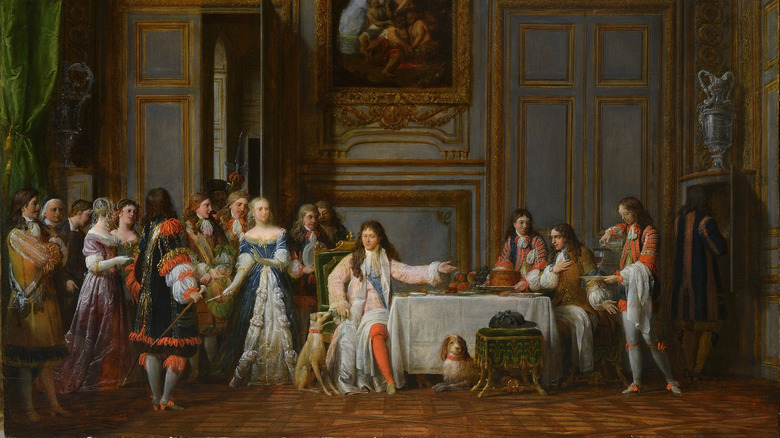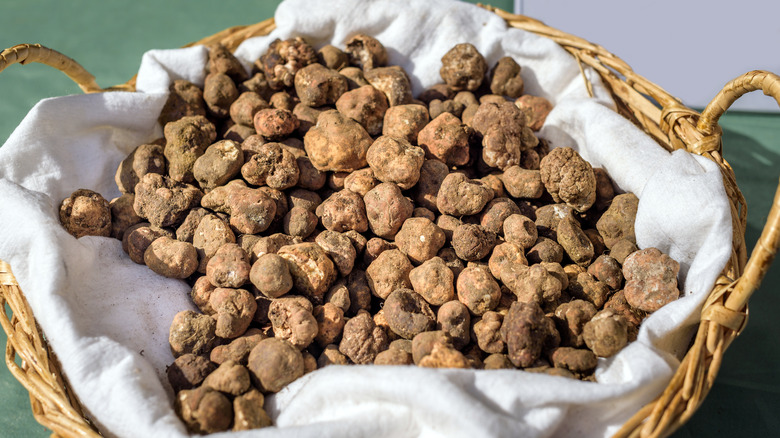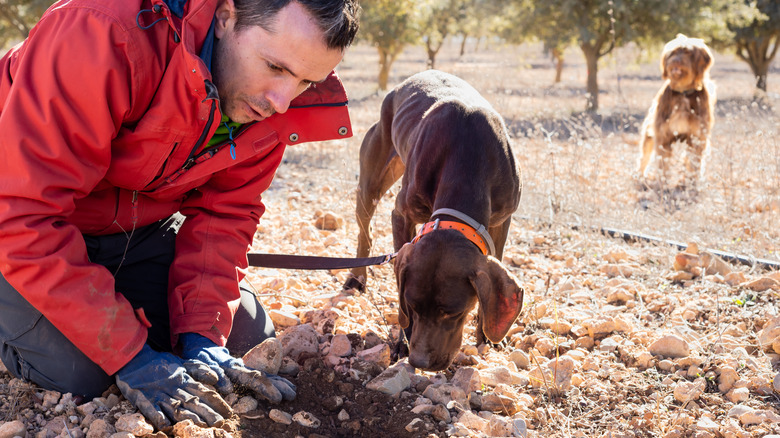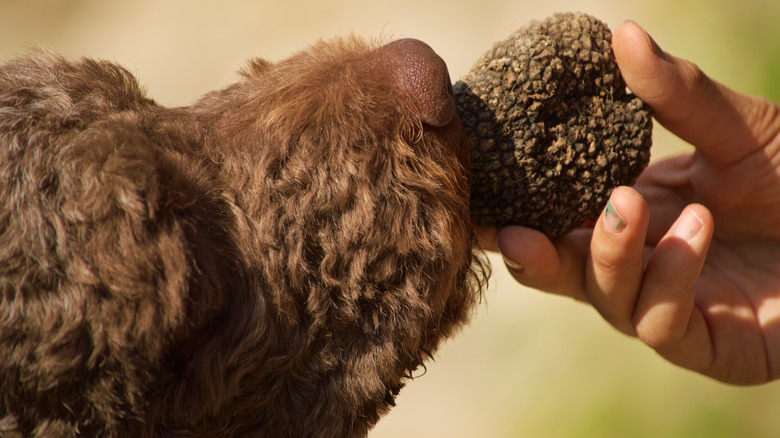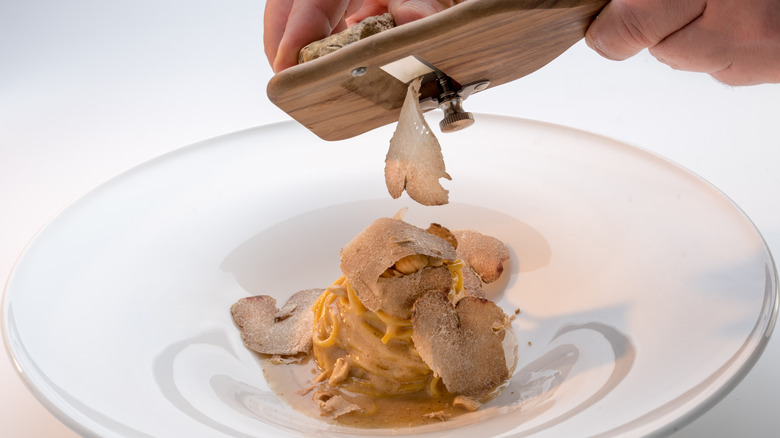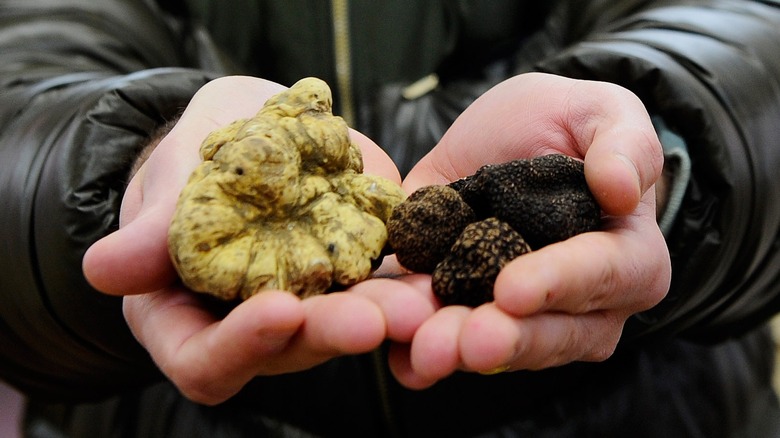The Truly Ancient Origins Of Truffles
In modern days, many of us light up when we see a truffle item on the menu. Seeing our favorite brand of infused oil go on sale is a triumph. But you might be surprised to know that the subterranean fungus inspired the same ecstasy in our ancient ancestors.
The first truffles to be eaten were believed to have been enjoyed by Sumerians, who existed in southern Mesopotamia between 4100 to 1750 B.C.. They are the first documented civilization to have been enraptured by the intoxicating scent and taste. But these irresistible tubers have existed on Earth for even longer than that. In fact, they've graced our planet for millions of years. In addition to delighting palates over the centuries, the truffle has been the subject of myth and legend that suggest they are of divine origin.
Now they serve as an indulgence that is even accessible at your local supermarket. Yet, they still provoke mystery. "Wheat has been planted for more than 4,000 years, but the truffle only 50 years ago. We still have a long way to go to understand the truffle and its development," Faustino Terradas of Trufas del Nuevo Mundo told Smithsonian Magazine. Read on to learn more about history's most alluring ingredient.
Truffles in nature
Truffles are formed in nature through a symbiotic relationship between a tree and a fungus. The tuber starts out as a spore that lives near the roots of certain trees, including beech, poplars, oak, and pines. They do this to soak up water and exchange nutrients and sugars. What you eat is the fruit of the fungus. Beetles are believed to be responsible for spreading truffle spores all over the world. These culinary delicacies are estimated to have existed on Earth for between 85 and 50 million years. There are also some species that grow in the desert in places like Morocco and Saudi Arabia.
These yummy fungi evolved to become an integral part of the ecosystem in many habitats and are responsible for keeping some species alive. You might be envious of the U.S. Western red-backed vole and the northern flying squirrel. Their diets, as well as that of the Australian long-footed potoroo, consist almost wholly of truffles.
Truffles and the Babylonians, Sumerians, and Egyptians
The Sumerians, who lived between 4100 and 1750 B.C., are said to have mixed truffles with legumes and veggies. The first documented account of the kitchen jewel is believed to have appeared in Neo-Sumerian inscriptions describing the diet of their enemies, the Amorites. Babylonians in 3,000 B.C. would scour the beaches and desert sands for them. Amorite kings and King Zimrilim of Mari, who lived between 1779 and 1761 B.C., would serve baskets of them at banquets along with chickpea dishes and fried grasshoppers.
The Egyptians were also big fans of truffles and ate them coated in goose fat. Pharaoh Khufu, who built the Great Pyramid at Giza, was known to always serve them at his table when entertaining guests. King Ramses II is believed to have had images of them painted into frescoes on the walls of the pyramids he built. These rulers, however, only reserved them for royalty and prevented their people from enjoying them. There are also hieroglyphics showing Egyptians offering the tasty tubers to the gods.
Truffles and the Greeks and Romans
Truffles are documented to have been held in high esteem by the ancient Greeks, Etruscans, and Romans. These cultures believed the tubers to have lasting healing benefits for both the soul and body. The intoxicating flavor and aroma of these black diamonds made them a staple in the kitchens of the aristocracy.
Greek philosopher Theophrastus, who lived from 371 to 287 B.C., wrote that truffles were created when thunder struck as autumn rain fell. Roman poet Juvenal agreed. Cicero (104 to 43 B.C.) called truffles "children of the Earth."
Roman author Pliny the Elder, who lived from 24 B.C. to 70 A.D., wrote about truffles in his book "Naturalis Historia." Plutarch of Chaeronea (45 BC to 120 A.D.), a philosopher, surmised that they were grown through a trifecta of water, heat, and lightning. The word "truffle" was derived from "tuber" in Latin, which means lump.
Legend and lore of truffles
The savory taste of a truffle is so exhilarating to some that it has been associated with the magical or supernatural throughout history and in modern times. Many saw them as God's gift to humanity. An ancient myth says that they helped a barren farmer and his wife have 13 children. The couple dined on the subterranean fungi after seeing their pig dig one up and ingest it. Egyptians believed they were "sons of the gods" and "plants of immortality." Another legend said that Set, the storm god, made them by throwing mushroom-seed-laden firebolts down to Earth. Aphrodite, the Greek goddess of love and beauty, is said to have adored eating them.
The Greeks believed that it was Zeus' lightning bolt that made truffles after one hit an oak tree, while the Romans believed they came from Jupiter's thunderbolts. A story from the first century B.C. in the Mishna, a Jewish text, says that Onias the Rainmaker created a flood after a period without precipitation. He then asked for God's help again and God brought out the sun to dry up the land. That's when the starving locals began to gather the black diamonds that sprouted up all over the previously barren land.
The divine origin of the truffle is still believed by some desert truffle hunters today. Usama Calipha of Damascus told The New York Times in 2004, "The thunder cracks the land, and then they appear. It has something to do with the autumn rains, and it has something to do with God.”
Truffles became controversial in the Middle Ages
The deliciousness of truffles seemed to disappear during the Middle Ages. This is because of their enticing flavor and curious aroma. The church figured since they were so good, they must have come from the devil because, apparently, being happy and experiencing any sort of pleasure is evil. Some say that this association led them to be made into communion wafers for black masses, likely because of their black color or the fact that black truffles are believed to be an aphrodisiac.
Because of this, some became fearful of eating or selling these kitchen jewels during the Middle Ages. Truffles became branded as "witch's fares." But not everyone stopped enjoying the tuberous delicacies. They were added to different recipes by peasants to pump up flavors. Some well-off families also exchanged them as gifts. Even some popes found themselves indulging in black diamonds after moving to Avignon. Papal historian Bartolomeo Platina documented in 1481 that female pigs made the best truffle hunters as long as they were muzzled so they wouldn't gobble them all up.
Truffles made a comeback during the Renaissance
Per Urbani Truffles, the delightfulness of the truffle couldn't be subdued for long and the ingredient reappeared in Europe during the Renaissance when it was referred to as "the garlic of the riches." The Italian noblewoman Lucrezia Borgia, who lived between 1480 and 1519, was known to serve them at her lavish dinner parties. The fungus was held in high praise by King Francis I of France, who reigned between 1515 and 1547 and fed them to his court. Caterina de' Medici, who served as queen consort and regent in France from 1547 to 1574, did the same.
Royal courts would engage in truffle hunting as a form of entertainment when guests would visit. King Louis XIV of France was so captivated by them he made sure they returned as a staple in the culinary scene of the elite. He even tried, unsuccessfully, to cultivate them. Doctor Alfonso Ciccarelli of Umbria wrote an entire book on them in 1564 titled "Opusculus de Tuberis." Botanist, doctor, and philosopher Andrea Cesalpino identified truffles as mushrooms for the first time in 1593.
Truffles during the 1700s and 1800s
The study of these tasty morsels continued after the Renaissance with English researcher John Ray. Ray discovered truffle spores in 1699. Etienne François Geoffroy, a French botanist, further solidified black diamonds as a part of the fungi family in 1711, while Giovanni Bernardo Vigo of Florence identified two species of black truffles as Tuber melanosporum and Tuber aestivum in 1729.
Truffles were also the subject of works by Michel-Jean de Borch of Poland in his 1780 "Lettres sur les Truffes du Piémont," as well as the books "La Cuisine de Touts les Pays" and "Cuisine Classique" by French chef Urbain Dubois, who lived from 1818 to 1901. Truffles were regularly found in Parisian markets in the 1780s and were picked seasonally on grounds where peasants lived and enjoyed them regularly. The rich extracted these gems from the grounds of the poor only to turn around and sell them at a high cost so that they became only available to nobles and their mistresses.
Sometimes these black diamonds even made them cry. Italian composer Gioacchino Rossini, who lived from 1792 to 1868, famously said, "I have wept three times in my life. Once when my first opera failed. Once again, the first time I heard Paganini play the violin. And once when a truffled turkey fell overboard at a boating picnic" (via Le Trifole Davide Curzietti). The production of these kitchen jewels exploded by the mid-1800s with more than 2,000 tons of truffles circulating in Europe.
Truffles in the 20th century
Right before the turn of the 20th century, King Kaiser Wilhelm I of Prussia commissioned Professor A.B. Frank of the Landwirtschaftlichen Hochschule in Berlin to study a way to mass-produce truffles. This would make them more widely available and less expensive. This attempt was unsuccessful, but Frank's research is said to have successfully furthered modern attempts at cultivation.
Restaurateur and hotel magnate Giacomo Morra set out to celebrate truffles in 1929 by launching an event called the International Alba White Truffle Fair. He founded Tartufi Morra in 1930, the first company to market the white truffle which is referred to as the "Truffle of Alba." Part of his marketing tactics for the event included bestowing one of the largest kitchen jewels he could find on prominent figures. "The Truffle of the Year” was given to individuals like President Harry Truman, Marilyn Monroe, Joe DiMaggio, and Winston Churchill.
Unfortunately, truffle production dwindled after World War I since there was mass destruction of land and the shutdown of fields where they grew. Rising temperatures combined with a reduction in precipitation are also said to have contributed to smaller harvests in places like France. It is believed that only 400 tons of them were produced per year in Europe by the 1960s, making them very rare and used only for special occasions.
Where can you find them today?
Throughout history, high-quality truffles typically only grew wild in Europe and were spread around by bugs and animals like squirrels, pigs, and dogs. However, they now grow throughout the world. Cultivation has spread over the last 50 years to places like Turkey, China, Chile, and the U.S. This was aided by Frank's research, which revealed that truffles only grew near certain trees and that there was a mutually beneficial relationship between the two.
This helped modern-day truffle farmers to play with the precise conditions for optimal growth including soil acidity, temperatures, and precipitation. A successful cultivation method was finally developed in the 1970s in France. "In a nursery, it's first a matter of attaching the fungus spore to the roots of the tree," Faustino Terradas, sales manager of Trufas del Nuevo Mundo, told Smithsonian Magazine. "The spore then begins to germinate and generate a mycelium, or a fungus root, that is going to cover the root of the tree. Then it is taken to the field and planted."
But the tree has to be grown under specific conditions and even with all this careful planning and manipulation, there are many uncertain variables that could affect the truffle's outcome. Different growers also have different techniques that they keep secret. The first truffle to have been grown in the U.S. was harvested in 1987 in California. Chile began domesticating them in 2009. There are now more than 1,000 farms located outside of Europe.
How are they harvested today?
Truffles are still mostly extracted from the ground using the same methods that were used hundreds of years ago. These balls of fungi are sniffed out and dug up by pigs and dogs. But dogs are used more often since pigs tend to eat what they find. These black diamonds have a similar scent to a male pig's sex hormones. Female swine become extremely anxious to track the scent and refuse to let it go. It takes a lot of muscle to wrestle a pig away after they've successfully caught onto the scent.
Dogs have between 100 and 300 million olfactory receptors that allow them to easily track these kitchen jewels in the ground. Canines are typically trained with treats. beagles, springer spaniels, lagotto Romagnolo, and golden retrievers are often put on the job for this task. Some humans hunt them out for themselves by looking to see where flies gather at the base of trees before using a rake for extraction. This, however, isn't advisable as it can cause harm to the tree's roots which can compromise the tree.
Truffles in modern culture
Truffles still remain a pricey delicacy today. However, while truffles were previously only reserved for the wealthy class, truffle-infused items are becoming more commonplace on moderately priced menus. Most people now know what a truffle is and can get a truffle-flavored item at their local grocery store. You'll find slivers of truffles topping a dish's main component or made into oil, salt, cheese, honey, soups, chocolate, butter, or sauce.
People also celebrate the gloriousness of the truffle at festivals in cities throughout Italy. At these events, you can buy the subterranean delights directly from hunters and purchase all kinds of truffle products and dishes from different artisans. They also feature wine tastings, demonstrations from prominent chefs, and activities for kids.
Truffles have become so embedded in modern culture that you'll even find them used in fast food. Shake Shack held a contest to send one lucky winner on a trip to Italy to go hunting for them to promote its fungi-infused menu. Even Hollywood is paying homage to the kitchen jewel's place in culture. A 2021 movie titled "Pig" starring Nicolas Cage told the tale of a hunter who was searching for his beloved foraging pig that was stolen.
The modern truffle industry
There are about 13 varieties of truffles that are coveted in the culinary world. And the efforts to make them widely available and consumed by the population are going strong. Truffle production is on the rise, with Spain being responsible for the highest yields of about 47 tons per year. Italy and France follow closely behind. This still doesn't come close to the 2,000 tons that were harvested hundreds of years ago. Now Europe only produces about 150 tons annually.
The black truffle market alone is believed to be worth about $295.7 million as of 2022. It is expected to grow to $496.6 million by 2028. A lot of 2.2 pounds of the black diamonds were sold for about $1,473 in 2022. White varieties can go for about $4,500 a pound. One that weighed 3.3 pounds, one of the largest ever found, was sold for $330,000 in 2009. It was unearthed by son and father Cristiano and Luciano Savini in Palaia, Italy, and auctioned off to billionaire Stanley Ho. The money from the sale of the tuber was distributed to various charities.
